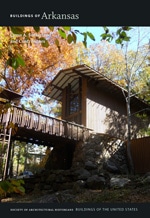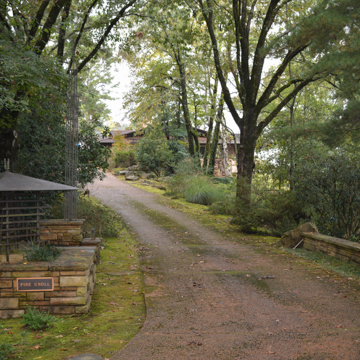Designed and built for career diplomat Graham Hall and his wife, Louise, Pine Knoll was Jones’s first Little Rock commission and his first commission far away from Fayetteville, his home. The distance from the site was intimidating to Jones, and he almost did not accept the commission since he did not feel that he would be able to adequately supervise it. His intense concerns with the commission, however, resulted in extremely thorough and careful planning for the project, and more than one hundred sheets of working drawings were completed for the house.
Located on a bluff overlooking the Arkansas River, the site that the Halls chose for Pine Knoll was just downstream from where they became engaged. Jones kept in mind Frank Lloyd Wright’s principle that a house should not sit on, but just over, a hill’s crest. As a result, the house’s main story stretches out along the length of the bluff, while a small lawn occupies the hilltop. The levels of the house unfold further as the hill descends to the river, giving the appearance of a singlestory house to the front of what is really a two-story house. The use of natural materials, specifically native limestone, for much of the walls blends the house with its surroundings, another Wrightian principle. Also Wrightian is the treatment of the walls, where the limestone is cut and laid in irregularly sized horizontal blocks. The grounds contain an original dovecote (now converted into a playhouse) that Graham Hall used for his hobby of raising and racing pigeons and a greenhouse with a custom-designed wood trellis.
Pine Knoll is a milestone design in Jones’s career. The commission took him beyond his native northwest Arkansas and resulted in national press coverage, bringing his architecture and his design philosophy to a much larger audience. With the exception of some minor interior changes, the house remains unaltered.


